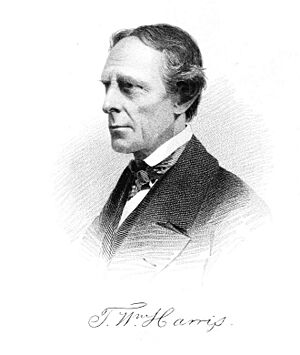Thaddeus William Harris facts for kids
Quick facts for kids
Thaddeus William Harris
|
|
|---|---|
 |
|
| Born | November 12, 1795 |
| Died | January 16, 1856 (aged 60) |
| Occupation | |
Thaddeus William Harris (born November 12, 1795 – died January 16, 1856) was an American scientist who studied insects, called an entomologist. He also worked as a librarian at Harvard University. Harris helped people understand more about insects, especially how they live and interact with plants. He was one of the first people to study insects that affect farms and crops. He also helped other scientists learn about this new field. For 25 years, Harris was the librarian at Harvard. He helped the library grow a lot and created one of America's first library card catalogs.
Contents
Early Life and Education
Thaddeus William Harris was born in Dorchester, Massachusetts, on November 12, 1795. His father, Thaddeus Mason Harris, was a minister and had also been a librarian at Harvard. Thaddeus Harris went to Harvard University and earned his first degree in 1815. He then studied medicine and became a doctor in 1820. He worked as a doctor until 1831. In 1824, he married Catherine Holbrook, and they had 12 children.
Studying Insects and Nature
Harris became very interested in insects while he was a student at Harvard. He learned about natural history from his teacher, William D. Peck. After finishing his studies, he spent much of his free time learning about insects.
First Discoveries and Publications
In 1823, Harris published his first paper. It was about the "Salt-marsh Caterpillar." His early work showed that he wanted to understand the full life cycle of insects. He also focused on insects that caused problems for farmers. By 1836, he had written many papers, mostly for farming or gardening magazines. He also wrote many letters to other scientists about how to classify insects.
Important Insect Report
In 1837, Harris was asked to write a special report about the insects of Massachusetts. This report was called A Treatise on Some of the Insects of New England, Which Are Injurious to Vegetation. It was published in 1842. This book helped farmers understand which insects were harmful to their plants. Later, new versions of his book were printed, even after he passed away.
Harvard University Librarian
In 1831, Harris became the librarian at Harvard University. He took over the job after the previous librarian, Benjamin Peirce, died. While working as a librarian, Harris also gave talks about nature. He even started the Harvard Natural History Society for students.
Cataloging Insects
In 1837, he was part of a group that studied animals and plants in Massachusetts. This led to his book, Systematic Catalogue of the Insects of Massachusetts. In this book, he listed 2,350 different kinds of insects! He tried to become a full-time professor at Harvard in 1842, but the job went to another scientist, Asa Gray.
Other Contributions
Thaddeus William Harris also helped start the Massachusetts Horticultural Society. This group helps people learn about gardening and growing plants. In 1827, he was chosen to be a Fellow of the American Academy of Arts and Sciences. This is a special honor for important scientists and thinkers.

